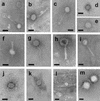Elevated abundance of bacteriophage infecting bacteria in soil
- PMID: 12514006
- PMCID: PMC152412
- DOI: 10.1128/AEM.69.1.285-289.2003
Elevated abundance of bacteriophage infecting bacteria in soil
Abstract
Here we report the first direct counts of soil bacteriophage and show that substantial populations of these viruses exist in soil (grand mean = 1.5 x 10(7) g(-1)), at least 350-fold more than the highest numbers estimated from traditional viable plaque counts. Adding pure cultures of a Serratia phage to soil showed that the direct counting methods with electron microscopy developed here underestimated the added phage populations by at least eightfold. So, assuming natural phages were similarly underestimated, virus numbers in soil averaged 1.5 x 10(8) g(-1), which is equivalent to 4% of the total population of bacteria. This high abundance was to some extent confirmed by hybridizing colonies grown on Serratia and Pseudomonas selective media with cocktails of phage infecting these bacteria. This showed that 8.9 and 3.9%, respectively, hybridized with colonies from the two media and confirmed the presence of phage DNA sequences in the cultivable fraction of the natural population. Thus, soil phage, like their aquatic counterparts, are likely to be important in controlling bacterial populations and mediating gene transfer in soil.
Figures

References
-
- Ashelford, K. E., J. C. Fry, M. J. Bailey, and M. J. Day. 2002. Characterisation of Serratia isolates from soil, ecological implications and transfer of Serratia proteamaculans subsp. quinovora, Grimont et al. 1983, to Serratia quinivorans corrig., sp. nov. Int. J. Syst. Evol. Microbiol. 52:2281-2289. - PubMed
-
- Bergh, O., K. Y. Borsheim, G. Bratbak, and M. Heldal. 1989. High abundance of viruses found in aquatic environments. Nature 340:467-468. - PubMed
Publication types
MeSH terms
Substances
LinkOut - more resources
Full Text Sources
Other Literature Sources

